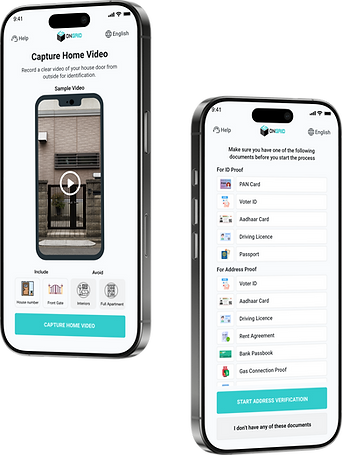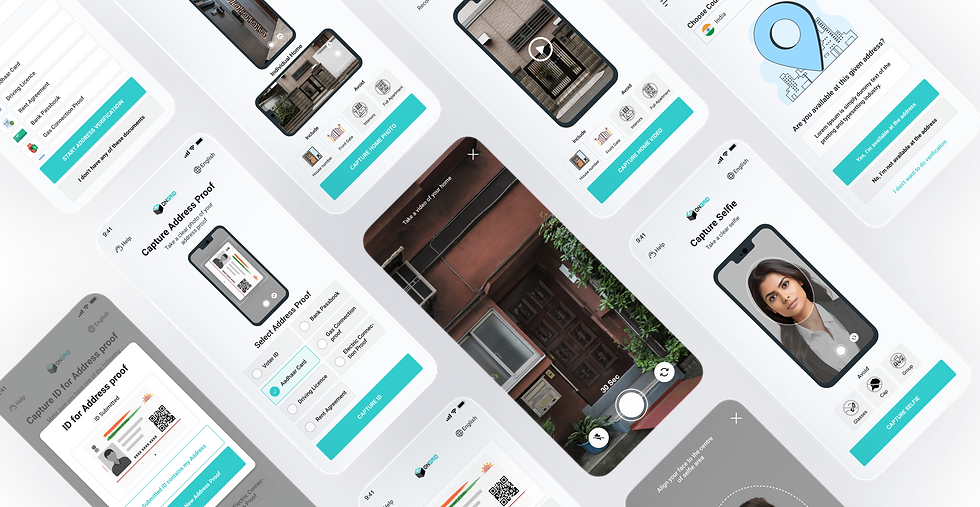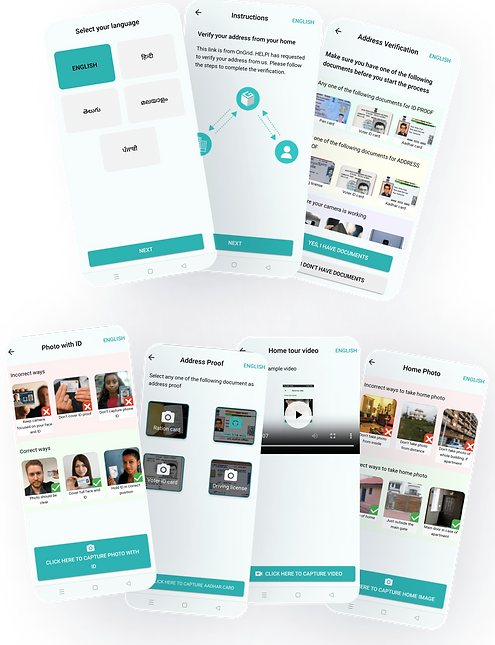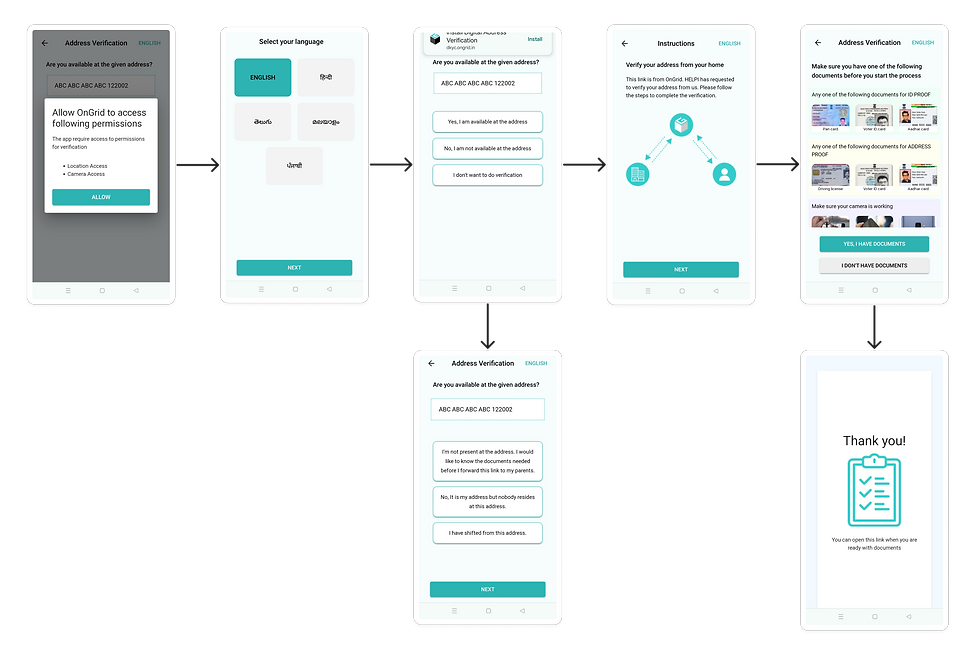To comply with my non-disclosure agreement, I have changed some of the quantitative data and omitted some information in this case study.
KPIs
-
Task Completion Rate Increased by 40%
-
Successfully reduced error rates and minimized support ticket volume
-
Reduced completion time by 30%
My Role
-
Heuristic analysis
-
User Research
-
Wire-framing
-
Hi-fidelity wireframes
-
User testing
My Team
-
Myself - Sole UI & UX Designer
-
Ranjan - Product Manager
-
2 Engineers - Front end & Back end
Introduction
What is Digital Address Verification?
Digital address verification is a quick and efficient method for confirming a candidate's residential address. It leverages technology to streamline the verification process, replacing traditional methods that can be time-consuming and prone to errors.
When is it Used?
Organizations across various industries utilize digital address verification, especially when:
-
Compliance is Essential: Regulations or industry standards mandate accurate address information. (e.g., financial services, legal fields).
-
Security is Paramount: Accurate address verification is crucial for roles requiring background checks or handling sensitive information.

Research
Understanding the Digital Address Verification Process
OnGrid's digital address verification process follows a secure and user-friendly flow:
-
Candidates receive a verification link via SMS or email.
-
Candidates submit required documents through their mobile device, including ID proof, selfie, and pictures/video of their residence.
-
OnGrid reviews the submitted documents for authenticity and address verification.
-
A comprehensive address verification report is then sent to the client (employer).
-
-
This digital approach expedites the verification process, minimizes errors, and ensures the security and integrity of candidate information.

Identifying the Need for Redesign
The existing mobile address verification flow, while functional, presented several challenges for users as identified through user testing, types of user tickets raised and heuristic analysis. These pain points significantly hindered the overall user experience.
Challenges identified in current flow
Unclear instructions
Confusing or inadequate instructions led to user frustration and errors.
Cumbersome Steps
The verification process contained unnecessary steps, increasing completion time and user burden.
Limited User Control
The flow lacked options for users to review or edit their submissions, reducing confidence.
Lack of visual hierarchy
The flow lacked a clear visual hierarchy, making it difficult for users to prioritize information and steps.
Outdated interface The existing interface felt dated, leading to navigation difficulties and frustration for users.
Clarity and Usability The analysis identified inconsistencies in language and unclear options, hindering user understanding.

Previous Design (Requires Refinement)
Design
The Redesign Approach
The redesigned flow prioritizes user experience by addressing these pain points and incorporating interactive enhancements. Our aim was to create a process that is:
Simple and user-friendly:
A streamlined flow with minimal steps and clear instructions.
Mobile-first design:
A modern interface optimized for mobile view
Informative and transparent: Clear explanations at each stage and real-time feedback.
User control and flexibility:
Options to retake pictures and review submissions for accuracy.
Enhanced User Interface:
Adopting the new, more sophisticated design system created for OnGrid
Redesigning for Efficiency: A User-Centered Approach
I redesigned the digital address verification flow by first integrating the new design system created for OnGrid. I started by creating wireframes that addressed previously identified pain points, ensuring the incorporation of best UX practices. After initial testing, I developed high-fidelity designs and shared the prototype with a larger group of users and stakeholders for further testing and feedback.

Digital Address Verifications Flow
Mapping the new user flow helped focus on a single user, their goals, and the steps they would take to achieve them. This analysis allowed me to assess key attributes such as the number of steps, error prevention, time taken for completion, and the elimination of unnecessary steps.

Designing for All: A User-Centric Approach
The redesigned address verification flow prioritizes user experience, catering to a diverse user base, including blue-collar workers. By incorporating clear and concise instructions, intuitive visual cues, and flexible options, the design ensures a seamless and inclusive experience for all users.
Introductory screens
The redesigned introductory screens prioritize user accessibility and ease of navigation. The new design showcases a step tracker provides users with a clear overview of the process, help options for guidance, clear exits for incomplete info, visual cues, and clear illustrative instructions.The UI itself adheres to accessibility standards and guidelines, ensuring seamless navigation for all users. These enhancements empower users with control and create a more intuitive and user-friendly experience throughout the verification process.

Screens Before

Identity & ID Verification Flow
Enhanced the identity and ID verification flow by providing clear, step-by-step instructions, intuitive visual cues for image capturing, and a simplified, refined UI to make ID selection more intuitive and user-friendly."

Screens Before

Address Verification Flow
Refined the address verification flow by allowing users to reuse information when selecting the same ID, minimizing redundancy and ensuring a seamless process. Incorporated intuitive capture tools and a comprehensive step preview, enabling error correction and giving users greater control over their verification journey

Conclusion
The redesigned address verification flow made the process more intuitive, efficient, and accessible. Through simplified ID selection, intuitive capture tools, and a clear, user-friendly interface, the new design empowers users to complete the verification process with ease and confidence. The addition of a comprehensive preview screen further enhances user control, allowing for error correction and ensuring a seamless experience. These improvements collectively contribute to a more efficient and user-centric verification process.
Next Steps
-
A/B Testing: Compare the new design with the previous version to measure improvements.
-
User Feedback: Continuously gather insights to refine the experience further.
-
Accessibility Checks: Regular audits to ensure inclusivity for all users.
This redesign not only improved usability but also set a strong foundation for ongoing enhancements.

